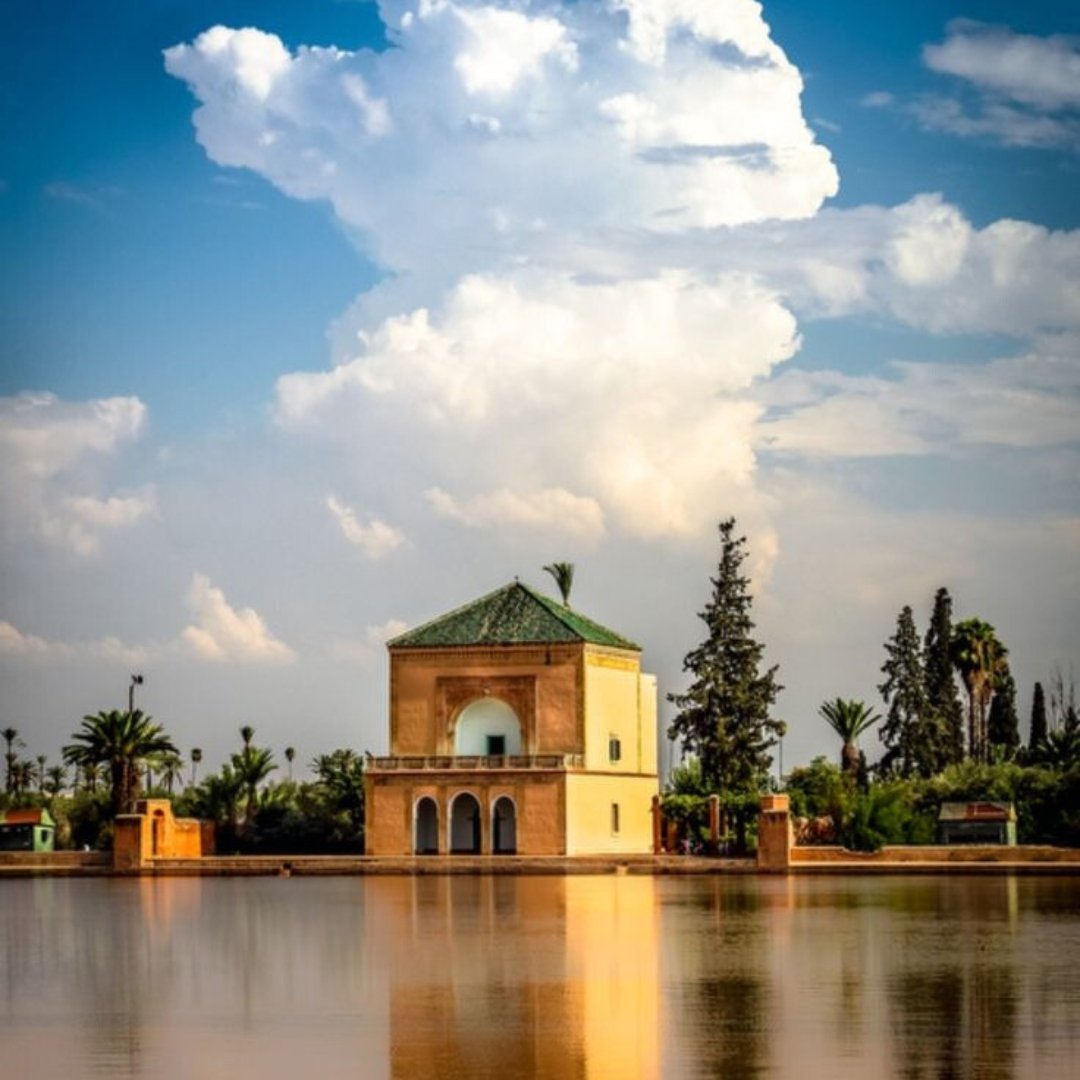Menara Gardens is one of the most famous and iconic sites in Marrakech, embodying the city’s serene beauty with the majestic Atlas Mountains as a backdrop. These historical gardens extend over a vast area and provide a peaceful haven away from the hustle and bustle of the Red City. In this comprehensive guide, we’ll explore the rich history of Menara Gardens dating back to the Almohad era, discover its unique features including the basin, pavilion, and olive groves, while providing detailed practical information about visiting, location, opening hours, and entry fees.
History of Menara Gardens: An Ancient Almohad Legacy
The history of Menara Gardens’ creation dates back to the Almohad dynasty period, as part of an ambitious project to secure water for the city and surrounding orchards. These gardens stand as living testimony to the ingenuity of ancient Moroccan engineers in water management and agriculture in a region characterized by its arid climate.
Creation of the Gardens and Basin in the Almohad Era (12th Century)
Menara Gardens was constructed in the 12th century under the rule of the Almohad dynasty, which had made Marrakech its capital. The primary purpose of these gardens was essentially agricultural, with the large basin designed as a huge water reservoir used to irrigate the surrounding olive groves. The irrigation system relied on an advanced engineering technique for its time called “khettara,” a system of channels that brought water from the Atlas Mountains.
Construction of the Pavilion (16th – 19th Centuries)
The famous pavilion overlooking the basin, which is now a symbol of Menara Gardens, was added later. Historical sources indicate that it was either built during the Saadian period in the 16th century or renovated in its current form during the Alaouite period in the 19th century. The Menara pavilion is distinguished by its characteristic green roof and architectural design that reflects traditional Moroccan style.
Menara Gardens continues to this day as a public park and historical monument that attracts both locals and tourists alike, and forms part of UNESCO’s World Heritage site within the old medina of Marrakech.
Main Features of Menara Gardens: The Basin, Pavilion, and Olive Groves
The features of Menara Gardens center around the vast basin and iconic pavilion, surrounded by extensive olive groves. These elements combine to form a unique landscape that reflects the harmony between human engineering and beautiful nature.
The Menara Basin: The Historical Reservoir
The Menara basin constitutes the beating heart of the gardens. It’s a rectangular water reservoir with impressive dimensions, measuring approximately 200 meters long by 150 meters wide. This basin was designed to serve as a water reservoir fed by the Atlas Mountains via a sophisticated system of channels. The basin reflects the pavilion and mountains in an enchanting way, creating an unforgettable photographic scene. The basin often contains fish, and visitors can enjoy sitting on its edges and appreciating the surrounding tranquility.
The Menara Pavilion: The Icon Overlooking the Basin
The Menara pavilion stands elegantly at the edge of the basin. It’s a small building characterized by its green roof that forms a beautiful contrast with the blue sky and the greenery of the surrounding trees. The pavilion follows traditional Moroccan architecture and consists of a few rooms and a terrace overlooking the basin. It was used in the past as a resting place for sultans and for receiving official guests. Today, this pavilion is the ideal place to take souvenir photos, especially with its reflection on the surface of the basin and the mountains in the background.
The Extensive Olive Groves
The olive groves of Menara Gardens extend over a large area, where centuries-old olive trees line up, some of which date back hundreds of years. These groves historically constituted the main source of olive oil production in Marrakech and were irrigated by water from the basin. These vast orchards offer ample space for walking and relaxing away from the noise of the city, where visitors can enjoy walking under the shade of the trees and listening to birdsong.
Importance of Menara Gardens: Heritage, Agriculture, and Natural Beauty
Menara Gardens derives its importance from several aspects:
- Historical testimony to Almohad ingenuity: The gardens are proof of the skill and innovation of Almohad dynasty engineers in the field of water management and agriculture, especially in a region with an arid climate.
- Historic agricultural area: They played an important role in supplying agricultural products to the city of Marrakech, especially olive oil, throughout the centuries.
- Tourism symbol of Marrakech: Menara Gardens, and particularly the view of the pavilion reflected in the basin with the Atlas Mountains as a backdrop, has become one of the most famous images representing Marrakech in tourism promotional materials.
- Natural space for inhabitants: They provide a large green space for local residents to enjoy nature and relax away from the noise of the city.
- Part of World Heritage: Menara Gardens, along with the Agdal Gardens, form part of the Marrakech medina site included in UNESCO’s World Heritage list.
Visiting Menara Gardens: Practical Guide
Menara Gardens is an ideal place to relax and capture iconic photos. Here’s a practical guide for your visit to ensure a pleasant and smooth experience.
Location of the Gardens and How to Get There
Menara Gardens is located in the southwest of Marrakech, about 3 kilometers from the old city (Medina). Due to its relatively remote location from the city center, reaching it on foot can be tiring for tourists staying in the center. Therefore, it’s preferable to use a taxi to get there, with the journey taking approximately 10-15 minutes from the old city. A main road leads directly to the pavilion and basin area, facilitating access.
Opening Hours of Menara Gardens
The gardens are generally open from early morning until sunset, allowing access to the olive groves area and basin throughout the day. As for the pavilion itself, it may have slightly different opening hours and may be closed at certain times. It’s advisable to check the pavilion’s opening hours before your visit, especially if access to it is an essential part of your plans.
Entry Fees to the Gardens and Pavilion
Entry to Menara Gardens (including walking through the olive groves and accessing the basin) is generally free, making it an excellent economical option for travelers. Entry to the pavilion itself may require a small nominal fee (approximately 10-20 Moroccan dirhams). These fees may change, so it’s recommended to check them before your visit.
What to Expect and Main Activities
During your visit to Menara Gardens, you can enjoy several activities:
- Walking among the olive trees: Enjoy a walk through the peaceful olive groves and appreciate the shade and clean air.
- Accessing the basin and pavilion: Discover the true heart of the gardens and admire the magnificent view.
- Taking photos: Be sure to capture the iconic image of the pavilion reflecting on the surface of the basin with the Atlas Mountains as a backdrop.
- Sitting by the water: Relax on the shores of the basin and enjoy the view and tranquility.
A typical visit to Menara Gardens takes about 30-60 minutes to see the main area around the basin and pavilion, and can extend longer if you wish to explore the olive groves more thoroughly.
Best Time to Visit and Take Photos
Late afternoon, especially just before sunset, is considered the ideal time to visit Menara Gardens and take photos. At this time, the light is warm and beautiful on the pavilion and mountains, creating exceptional images. Early morning is cooler and less crowded, but the lighting may be less dramatic for photography.
Places Near Menara Gardens
Due to its large size and location on the outskirts of the city, Menara Gardens is not directly surrounded by many other major tourist sites. However, it is situated at a strategic point near Marrakech-Menara Airport and on the route toward the Atlas Mountains. To reach the old city, you can head east for a distance of approximately 3 kilometers.
Some relatively nearby places include:
- Marrakech-Menara Airport: Located just a few minutes drive away.
- El Badi Palace: Accessible after a short period following a visit to Menara Gardens.
- Agdal Gardens: Other historical gardens that share some characteristics with Menara Gardens.
Conclusion: Menara Gardens… Tranquility, History, and Photographic Icon of Marrakech
Menara Gardens combines historical depth (through its link with the Almohad era), natural beauty, and tranquility, offering a refuge away from the hustle and bustle of the city. The basin and pavilion are among its most important features that make it worth visiting, especially given that they are easily accessible and free in most parts.
We invite you to visit Menara Gardens and enjoy its beauty and serenity, to capture the iconic images that will remain a beautiful memory of your visit to Marrakech. Don’t forget to share your experience and photos with us, and we wish you a pleasant visit to this unique historical monument!
Have you ever visited Menara Gardens? Share your experience in the comments below!






Leave a reply